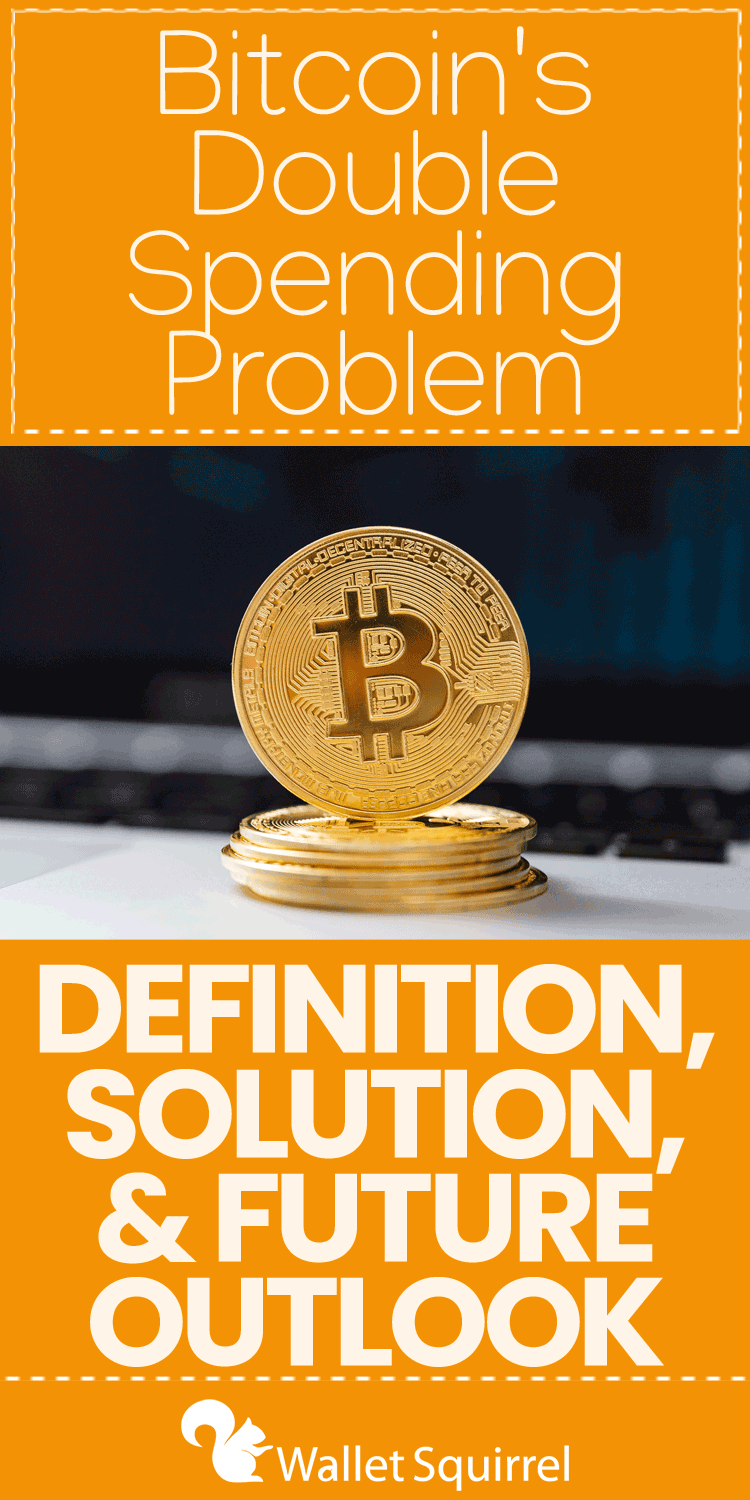Bitcoin’s Double Spending Problem: Definition, Solution, and Future Outlook

As new forms of technology and money become publicly available, bad actors are often some of the earliest adopters because the asset is largely untested or unregulated and thus more easily manipulated. Bitcoin is no exception.
Bitcoin’s completely digital currency network is decentralized—it has no central authority, regulators, or governing bodies to police thieves and hackers. Though traditional security entities don’t monitor the Bitcoin network for double-spending, other network defenses have been implemented to combat attacks that would otherwise threaten the network’s consensus mechanism and ledger of transactions, providing confidence to those who invest in Bitcoin.
What is the Double-spending Problem?
The double-spending problem is a phenomenon in which a single unit of currency is spent simultaneously more than once. This creates a disparity between the spending record and the amount of that currency available.
Imagine, for example, if someone walks into a clothing store with only $10 and buys a $10 shirt, then buys another $10 shirt with the same $10 already paid to the cashier. While this is difficult to do with a physical money—in part because recent transactions and current owners can be easily verified in real-time—there’s more opportunity to do it with digital currency.
Double spending is most commonly associated with Bitcoin because digital information can be manipulated or reproduced more easily by skilled programmers familiar with how the blockchain protocol works. Bitcoin is also a target for thieves to double-spend because Bitcoin is a peer-to-peer medium of exchange that doesn’t pass through any intermediaries or institutions.
How Does Double-spending Bitcoin Work?
Fundamentally, a Bitcoin double spend consists of a bad actor sending a copy of one transaction to make the copy appear legitimate while retaining the original, or erasing the first transaction altogether. This is possible—and dangerous—for Bitcoin or any digital currency because digital information is more easily duplicated. There are a few different ways criminals attempt to double-spend Bitcoin.
Simultaneously Sending the Same Bitcoin Amount Twice (or More)
In this situation, an attacker will simultaneously send the same bitcoin to two (or more) different addresses. This type of attack attempts to exploit the Bitcoin network’s slow 10-minute block time, in which transactions are sent to the network and queued to be confirmed and verified by miners to be added to the blockchain. In sneaking an extra transaction onto the blockchain, thieves can give the illusion that the original bitcoin amount hasn’t been spent already, or manipulate the existing blockchain and laboriously re-mine blocks with fake transaction histories to support the desired future double spend.
Reverse an already-sent transaction
Another way to attempt a Bitcoin double-spend is by reversing a transaction after receiving the counterparty’s assets or services, thus keeping both the received goods and the sent bitcoin. The attacker sends multiple packets (units of data) to the network to reverse the transactions, to give the illusion they never happened.
Blockchain Concerns with Double Spending
Some methods employed by hackers to circumvent the Bitcoin verification process consist of out-computing the blockchain security mechanism or double-spending by sending a fake transaction log to a seller and a different log to the network.
Perhaps the greatest risk for double-spending Bitcoin is a 51% attack, a network disruption where a user (or users) controls more than 50% of the computing power that maintains the blockchain’s distributed ledger of transactions. If a bad actor gains majority control of the blockchain, they can modify the network’s ledger to transfer bitcoin to their digital wallet multiple times as if the original transactions had not yet previously occurred.
Another concern is the potential double-spending problem on decentralized exchanges as crypto continues to migrate to decentralized exchanges (DEX) and platforms. With no central authority or intermediary, the growth and adoption of DEXs will depend on their security and proven ability to prevent double-spending.
Despite a variety of attempts to successfully double-spend Bitcoin, the majority of bitcoin thefts have not been the result of double-counting or double-spend attacks but rather users not properly securing their bitcoin.
How Does Bitcoin prevent Double Spending?
Bitcoin’s network prevents double-spending by combining complementary security features of the blockchain network and its decentralized network of miners to verify transactions before they are added to the blockchain. Here’s an example of that security in action:
Person A and Person B go to a store with only one collective BTC to spend. Person A buys a TV costing exactly 1 BTC. Person B buys a motorcycle that also costs exactly one BTC.
Both transactions go into a pool of unconfirmed transactions, but only the first transaction gets confirmations (blocks containing transactions from preceding blocks and new transactions) and is verified by miners in the next block.
The second transaction gets pulled from the network because it didn’t get enough confirmations after the miners determined it was invalid.
Security measure 1: Whichever transaction gets the maximum number of network confirmations (typically a minimum of six) will be included in the blockchain, while others are discarded
Security measure 2: Once confirmations and transactions are put on the blockchain they are time-stamped, rendering them irreversible and impossible to alter
Once a merchant receives the minimum number of block confirmations, they can be sure a transaction was valid and not a double spend.
Bitcoin’s proof-of-work consensus model is inherently resistant to double-spending because of its block time. Proof-of-work requires miners on the network, or validator nodes, to solve complex algorithms that require a significant amount of computing power, or “hash power.” This process makes any attempt to duplicate or falsify the blockchain significantly more difficult to execute because the attacker would have to go back and re-mine every single block with the new fraudulent transaction(s) on it.
This process compounds over time, preserving previous transactions while recording new transactions. Reaching consensus through proof-of-work mining provides the network accountability by verifying Bitcoin ownership in each transaction and preventing double-counting and other subtle forms of fraud.
While it is technically possible for a group of individuals to initiate a 51% attack on the Bitcoin network, combining mining power and disrupting the network for their benefit, it is unlikely and difficult as it would require collusion by a tremendous amount of miners or a single miner with over 50% of the network’s hash power. Successfully executing a 51% attack has only gotten more difficult over time, for a few reasons: the difficulty of mining Bitcoin increases with every Bitcoin halving; mining hardware is prohibitively expensive at that scale, and a massive amount of electricity would be required to power such a massive mining operation.
The Takeaway
Double spending of Bitcoin is a concern since it’s a digital currency with no central authority to verify its spending records. This leaves some to question the network’s security and legitimacy of Bitcoin’s network, validators, and monetary supply. However, the network’s distributed ledger of transactions, the blockchain, autonomously records and verifies each transaction’s authenticity and prevents double counting.
Though the blockchain can’t solely prevent double-spending, it is a line of self-defense before an army of decentralized validator nodes solve complex mathematical problems to confirm and verify new transactions are not double spent before they’re permanently added to the network’s permanent ledger.
Cryptocurrencies like Bitcoin can be volatile investments and prices change quickly due to news flow and other factors. Yet it’s that potential for highly fluctuating price changes that compels some investors—particularly those with a long-term investment horizon—to see out crypto as an investment.
With SoFi Invest® cryptocurrency trading, people of all experience levels can invest in cryptocurrencies like Bitcoin within a traditional investing platform, safely maintaining crypto alongside an investor’s stocks, bonds, and other assets.
Crypto: Bitcoin and other cryptocurrencies aren’t endorsed or guaranteed by any government, are volatile, and involve a high degree of risk. Consumer protection and securities laws don’t regulate cryptocurrencies to the same degree as traditional brokerage and investment products. Research and knowledge are essential prerequisites before engaging with any cryptocurrency. US regulators, including FINRA, the SEC, and the CFPB, have issued public advisories concerning digital asset risk. Cryptocurrency purchases should not be made with funds drawn from financial products including student loans, personal loans, mortgage refinancing, savings, retirement funds, or traditional investments.
Third-Party Brand Mentions: No brands or products mentioned are affiliated with SoFi, nor do they endorse or sponsor this article. Third-party trademarks referenced herein are property of their respective owners.
SoFi Invest®
The information provided is not meant to provide investment or financial advice. Investment decisions should be based on an individual’s specific financial needs, goals and risk profile. SoFi can’t guarantee future financial performance. Advisory services offered through SoFi Wealth, LLC. SoFi Securities, LLC, member FINRA / SIPC. SoFi Invest refers to the three investment and trading platforms operated by Social Finance, Inc. and its affiliates (described below). Individual customer accounts may be subject to the terms applicable to one or more of the platforms below.
1) Automated Investing—The Automated Investing platform is owned by SoFi Wealth LLC, an SEC Registered Investment Advisor (“Sofi Wealth“). Brokerage services are provided to SoFi Wealth LLC by SoFi Securities LLC, an affiliated SEC-registered broker-dealer and member FINRA/SIPC, (“Sofi Securities).
2) Active Investing—The Active Investing platform is owned by SoFi Securities LLC. Clearing and custody of all securities are provided by APEX Clearing Corporation.
3) Cryptocurrency is offered by SoFi Digital Assets, LLC, a FinCEN registered Money Service Business.
For additional disclosures related to the SoFi Invest platforms described above, including state licensure of Sofi Digital Assets, LLC, please visit www.sofi.com/legal.
Neither the Investment Advisor Representatives of SoFi Wealth, nor the Registered Representatives of SoFi Securities are compensated for the sale of any product or service sold through any SoFi Invest platform. Information related to lending products contained herein should not be construed as an offer or pre-qualification for any loan product offered by SoFi Lending Corp and/or its affiliates.









